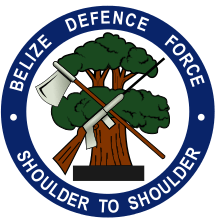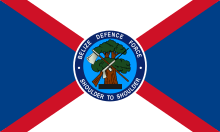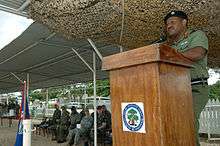Belize Defence Force
The Belize Defence Force (BDF) is the military of Belize, and is responsible for protecting the sovereignty of the country. The BDF is under the Ministry of Defence, which is currently headed by Hon. Michael Peyrefitte; the BDF itself is commanded by Brigadier General Steven Ortega. In 2012, the Belizean government spent about $17 million on the military, constituting 1.08% of the country's gross domestic product (GDP).[2]
| Belize Defence Force | |
|---|---|
 Belize Defence Force emblem | |
 Belize Defence Force flag | |
| Motto | Shoulder To Shoulder |
| Founded | January 1978 |
| Service branches | Ground Forces Air Wing Belize Coast Guard Service |
| Headquarters | Price Barracks, Ladyville |
| Website | www |
| Leadership | |
| Commander-in-Chief | Elizabeth II |
| Minister of National Security | Hon. Michael Peyrefitte |
| Commander | Brigadier General Steven Ortega |
| Manpower | |
| Conscription | No |
| Active personnel | Approx 1330 (2016)[1] |
| Reserve personnel | 750 (2016)[1] |
| Expenditures | |
| Budget | $US 32 million (2012)[1] |
| Related articles | |
| Ranks | Military ranks of Belize |
History

The military of Belize dates back to 1817, when the Prince Regent Royal Honduras Militia, a volunteer organization, was founded. Between 1817 and 1978, the military force in Belize has had ten different names:[3]
- The Prince Regent's Royal Militia (1817-1866)
- The Belize Volunteer Force (1866-1868)
- The Belize Volunteer Corps (1868-1883)
- The Belize Light Infantry Volunteer Force (1897-1905)
- British Honduras Volunteers (1905-1916)
- British Honduras Territorial Force (1916-1928)
- British Honduras Defense Force (1928-1944)
- British Honduras Home Guard (1942-1943)
- British Honduras Volunteer Guard (1943-1973)
- Belize Volunteer Guard (1973-1977)
The BDF was founded in 1978 following the disbanding of the Belize Volunteer Guard and the Police Special Force the year before.[4]
After Belize achieved independence in 1981 the United Kingdom maintained the deterrent British Forces Belize in the country to protect it from invasion by Guatemala. During the 1980s this included a battalion and No. 1417 Flight RAF of Harriers. The main British force left in 1994, three years after Guatemala recognised Belizean independence, but the United Kingdom maintained a training presence via the British Army Training and Support Unit Belize (BATSUB) and 25 Flight AAC until 2011 when the last British Forces left Ladyville Barracks, with the exception of seconded advisers.[4] The BDF Maritime Wing became part of the Belize Coast Guard Service in November 2005.[5]
In October 2015, due to rising tensions between Belize and Guatemala and the British cutback on military bases worldwide to focus on the War On Terror in 2011, Belize asked the UK to bring BATSUB back; the British Government brought BATSUB to Belize once again.[6]
Organization
The BDF consists of:
- Three infantry battalions, each comprising three companies[1]
- Three reserve companies[1]
- One support group[1]
- Air Wing[1]
The Belize Police Department is staffed by 1200 sworn officers and 700 civilian staff (2008).[7] The Belize Police Department and National Forensic Science Service report to the Minister of National Security.
As of 2012, there are also 40 British Army personnel stationed in Belize.[1]
Crew-served weapons
| Weapon | Origin | Type | Quantity | |||
|---|---|---|---|---|---|---|
| Transport | ||||||
| Recoilless rifle | Sweden | anti-armor anti-personal | 6[1] | |||
| L16 81mm | United Kingdom | portable mortar | 6[1] | |||
Aircraft
| Aircraft | Origin | Type | Variant | In service | Notes | |
|---|---|---|---|---|---|---|
| Transport | ||||||
| Britten-Norman BN-2 | United Kingdom | transport / utility | 1[8] | |||
| Helicopters | ||||||
| Bell UH-1 | United States | utility | UH-1H | 2[8] | ||
| Trainer Aircraft | ||||||
| T67 Firefly | United Kingdom | basic trainer | M260 | 1[8] | ||
Facilities
- Mountain Pine Ridge Training Area - south of Belmopan used for jungle warfare by Belize, US, Dutch and British forces
- Price Barracks - Ladyville - Air Wing HQ and former British helicopter base; it is named for the country's first Prime Minister George Cadle Price
- Fairweather Camp - Punta Gorda Town - HQ for 2nd Bat and former British military base
- Orange Walk Airport (Army) - Orange Walk District
- Belizario Camp - San Ignacio - border area base
- Corozal Training Centre - Corozal Town
- Dangriga Training Centre - Dangriga
- Philip S. W. Goldson International Airport - main airbase
- Hector Silva Airstrip - small base located south of the airstrip; this is a secondary airstrip and was used by the British Army
- Punta Gorda Airport is a secondary airstrip
- St. George's Caye (Army)
- Holdfast Camp (Army)
- Baldy Beacons (Army)
- Rideau Camp (Army)
- Salamanca Camp (Army)
- Militia Hall- Belize City
References
- Notes
- IISS (2012), p. 374
- "Belize". CIA World Factbook.
- D.N.A. Fairweather, A Short History of the Volunteer Forces of British Honduras (now Belize)
- Phillips, Dion E. (2002). "The Military of Belize". Archived from the original on 2012-12-11.
- "Belize". Channel 5. 13 December 2007. Archived from the original on 2011-05-04.
- "No Joke Jimmy,The Brits Are Back". 7 News Belize. Retrieved October 28, 2015.
- "Belize Police Department - About the Department". Police.gov.bz. Archived from the original on 2019-02-18. Retrieved 2012-06-08.
- "World Air Forces 2020". Flightglobal Insight. 2020. Retrieved 2 January 2020.
- Works cited
- International Institute for Strategic Studies (IISS) (2012). The Military Balance 2012. London: IISS. ISSN 0459-7222.
External links
![]()